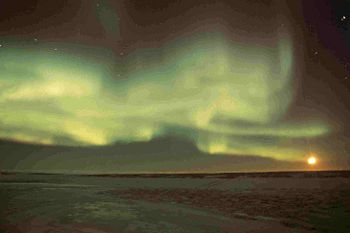Aurora Borealis: Difference between revisions
imported>George Swan (first draft) |
imported>George Swan (spelling) |
||
| Line 4: | Line 4: | ||
The '''Aurora Borealis''', also called '''the Northern Lights''', is an electomagnetic phenomenon visible near the [[north magnetic pole]]. | The '''Aurora Borealis''', also called '''the Northern Lights''', is an electomagnetic phenomenon visible near the [[north magnetic pole]]. | ||
Observers describe the Auroras impressive. [[First Nations]] peoples told tales to interpret their meaning. | Observers describe the Auroras as impressive. [[First Nations]] peoples told tales to interpret their meaning. | ||
[[Planet Earth]] is surrounded by a [[magnetic field]]. The magnetic field captures [[charged particles]] from outer space, and diverts them to the Earth's magnetic poles. | [[Planet Earth]] is surrounded by a [[magnetic field]]. The magnetic field captures [[charged particles]] from outer space, and diverts them to the Earth's magnetic poles. | ||
Revision as of 18:06, 26 August 2008
The Aurora Borealis, also called the Northern Lights, is an electomagnetic phenomenon visible near the north magnetic pole.
Observers describe the Auroras as impressive. First Nations peoples told tales to interpret their meaning.
Planet Earth is surrounded by a magnetic field. The magnetic field captures charged particles from outer space, and diverts them to the Earth's magnetic poles. When these charged particles interact with the upper atmosphere there are various kinds of exchanges of energy, resulting in the transmission of photons of various frequencies -- including visible light.
The source of most of the extraterrestrial charged particles is the solar wind. And the intensity of the aurora borealis, and a corresponding Aurora Australis around the south magnetic pole is directly related to the intensity of the solar wind.
When the solar wind is at its most intense it can knock out telecommunication satellites.
